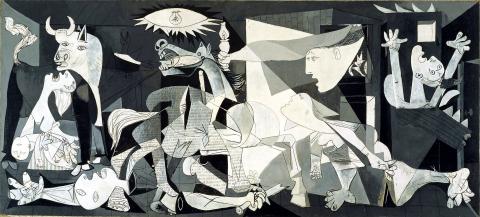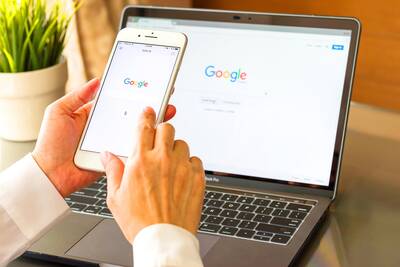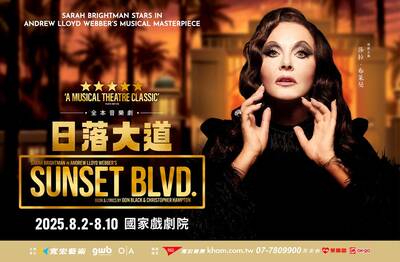Picasso’s Guernica, standing at almost 3.5 meters tall and 7.7 meters wide, depicts a scene from the Spanish Civil War. It shows the intense aerial bombardment of the town of Guernica in the Basque Country that happened on Apr. 26, 1937, carried out by the Nazi German Luftwaffe at the behest of the Franco government.
The canvas is filled with the chaos, screams and slaughter of people and animals, showing their contorted body shapes and features in a classic example of Cubism, a form that juxtaposes diverse aspects and planes of three-dimensional objects onto a two-dimensional painting, as with, for example, a pair of eyes represented incongruously together in profile.
The painting is less a depiction of an actual scene and more a cacophany of symbolic elements evoking the psychological impact of the violence of war, with the frenzied barbarism of the Spanish bull, the broken blade of a sword and the iconography of the pieta — the Virgin Mary holding the dead body of Christ in her arms — on the far left of the composition, the woman’s distorted facial features and breasts, her back, shoulders, neck and head exaggerated and contorted, conveying the primal, profound grief tearing through her. If dreams work in the language of symbolism, Guernica is like the shards of a nightmare reassembled onto canvas.

Photo: Wikimedia Commons
照片:維基共享資源
The history of art is dotted with denunciations of war, but Picasso has chosen here not to spatter his work with blood, and to instead employ understated black and grey tones, reining in the chaos, as if to suppress — and even mute entirely — the volume of the shrill cries. In so doing he has actually accentuated the terror.
When he was preparing for this piece, Picasso studied news photographs of the event. It is perhaps because of this that he decided to render this painting in a monochrome palette, adding the texture of newsprint, to evoke the feeling of a photojournalist’s report.
(Translated by Paul Cooper)

Photo: Wikimedia Commons
照片:維基共享資源
畢卡索的《格爾尼卡》以高近三點五公尺,長逾七點七公尺的畫幅,描繪西班牙內戰時期,巴斯克地區格爾尼卡城在一九三七年四月二十六日所受的地毯式轟炸,此為佛朗哥政府授意德國納粹軍隊所為的種族屠殺。
畫面中充滿了動態的、嚎叫的、瀕死的人與動物,其扭曲錯置的身形五官,是典型的立體派表現方式——把三度立體空間的多面向像比目魚的眼睛一般並置到平面畫幅中。
此畫並非描繪特定的場景,而是將戰爭暴力的心理衝擊,訴諸象徵元素:例如西班牙公牛的暴力野蠻、斷裂的刀劍,以及「聖殤」的圖像 —— 畫面左方的婦女抱著死去的孩子,她變形的臉部和乳房,她的背、肩、頸、頭部誇張地扭曲,傳達出最原始深切的哀痛。如果說夢是以象徵的語言運作,《格爾尼卡》便像是把夢魘的材料絞碎之後,再平貼到畫布上。
對戰爭的控訴,在藝術史上屢見不鮮。但畢卡索畫的不是鮮血淋漓,而是內斂的黑灰色調、抑制的騷動,似乎是把尖叫的音量壓低,甚至是靜音了,代之而起的卻可能是更令人怖懼的戰慄。
為了創作此作品,畢卡索研究了相關的新聞照片;或許這也是為什麼此幅畫全以黑、灰、白表現,其中並有如新聞紙的材質,如同另一種紀實攝影報導。
(台北時報林俐凱)

A: Apart from the musical Sunset Boulevard, Japanese pop diva Ayumi Hamasaki is also touring Taiwan after a 17-year wait. She’s holding two concerts starting tonight. B: Ayu has the most No. 1 hits of any Japanese solo artist, with 33 total. A: “Time” magazine even crowned her as “The Empress of Pop.” B: She staged shows in Taipei back in 2007 and 2008, causing an “Ayu fever” across Taiwan. A: Unfortunately, the singer has been deaf in her left ear since 2008, and is gradually losing hearing in her right ear. I’m so excited to see her singing in Taipei again. A: 除了音樂劇《日落大道》,日本歌后濱崎步睽違17年,今晚起在台北熱唱兩場。

Denmark’s state-run postal service, PostNord, announced that it would cease letter deliveries at the end of 2025 due to the impact of digitalization. As 95% of its residents now use the Digital Post service, Denmark has seen a 90% decline in letter volumes since 2000, from 1.4 billion to 110 million last year. On top of that, the Postal Act of 2024 removes the government’s obligation to provide universal mail service and puts an end to postal exemptions from value-added tax, raising the cost of a single letter to 29 Danish krone (US$4.20). As a result, PostNord is switching

A: After touring Taipei, the play Life of Pi is now heading to Taichung. You wanna go? B: Did you forget? We’re going to Taipei this weekend to see the musical Sunset Boulevard and go to Japanese pop diva Ayumi Hamasaki’s concert. A: Oh yeah, that’s right. The classic composed by Andrew Lloyd Webber is touring Taiwan for the first time. B: I heard that it’s adapted from a 1950 film with the same title. A: And the show will feature legendary soprano Sarah Brightman, who is finally returning to the musical stage after 30 years. We can’t miss it. A: 在台北巡演後,戲劇《少年Pi的奇幻漂流》本週起將移師台中。要去嗎?

Although sending you an SMS (Short Message Service) verification code provides some security, many apps now use code-generating apps and two-factor authentication instead. But more recently, passkeys now use a biometric approach to logging in. Biometrics can offer an even more secure alternative. Following this trend, Google is reportedly planning to replace SMS verification codes with “QR code” scanning. SMS codes are currently used to verify user identity and prevent fraudsters from creating fake Gmail accounts to distribute spam. However, these codes present several challenges. They can be phished through suspicious links, and users may not always have access